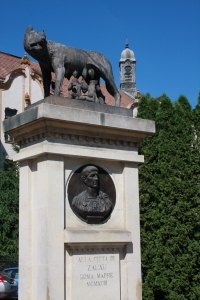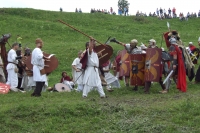Dacia Porolissensis was one of the Roman provinces formed on the Romanian territory as a result of the reorganization of Dacia province, during the Roman emperor Hadrian (117-138 AD). Besides Dacia Porolissensis, the former province of Dacia included the provinces of Dacia Superior and Dacia Inferior.
The reason for reorganizing Dacia was the repeated attacks of the Iazygi Sarmatians and the Roxolans that modified the strategic military needs of the Roman province founded at the north of the Danube in 106 AD. Through this reorganization, the three new provinces could defend themselves more easily against the barbarian attacks. The reorganization was initiated in 118 AD by the governor Q. Marcius Turbo. The novelty is that each new province had its own army, being able to act independently.
The province Dacia Porolissensis was ruled by a governor with equestrian rank, procurator Augusti. He had in his authority only auxiliary troops, but no legions. He was not below the legatus pro praetore from Apulum. The province's procurator had its residence at Porolissum. In terms of area, Dacia Porolissensis included the territory from the north of the rivers Mureş and Arieş, being detached from the northern of the former province Dacia Augusti.
The first documentary record of Dacia Porolissensis is made on August 10th, 123 AD, in the military diploma discovered at Gherla, but, must probably, it was founded in 118 AD when Dacia Superior also appeared. This territorial organization will be maintained until the Emperor Marcus Aurelius (161-180) when the Dacian provinces will be restructured again due to the new military strategic needs.
For the list of the Roman troops stationed in Dacia Porolissensis, click here
Porolissum Roman Castrum lies on the administrative territory of the following villages: Moigrad (in Mirşid commune), Brebi and Jac (Creaca commune, Salaj county). The total area of the site is approximately 500 hectares, from which only a small surface was researched (less than 10%).
Capital of the Roman province Dacia Porolissensis, Porolissum was probably founded in the summer of 106 AD. The birth certificate of the settlement is represented by the military diploma discovered here. Issued in August 10th 106 AD, this diploma (two bronze plaques with Latin inscriptions) is certifying that Marcus Ulpius Novantico, soldier in a military unit of the Roman army in Dacia province, gain the roman citizenship.
Fact: Roman citizenship, with all the rights resulting from being a Roman citizen, was also obtained by the military's family members, as a reward for the military service he performed in the Roman army.
The toponym Porolissum, thought to be of Dacian origin, means "passage way", "gate" and it is closely related to the proximity of the "Porta Mesesina - Poarta Meseşană" - an important gateway between the Pannonian and Transylvanian area. The passage had a great strategic and military importance since antiquity.
Fact: Before the Romans' arrival, Dacians controlled the transit through this gate, from a fortress, archeologically identified on Poguior hill, that dominates the place but also from the important Porolissum Dava (the Dacian word for settlement), mentioned by the ancient Greek geographer Ptolemeu in his work "Geography".
Porolissum developed as a civilian settlement around the Roman military camp, becoming a flourishing border town, with a significant economic, commercial and production potential, but also a powerful center of Roman spirituality. Thus Porolissum had an important role in the dissemination of the Roman civilization.
Fact: When choosing a Roman camp site there were taken into consideration precise principles and criteria. First of all, the location of the fortification was chosen regarding some factors: the shape of the land, air currents, position to the main cardinal points and to the closest border, sun exposure, and natural drainage of the areas. Therefore the location was chosen based on precise military and strategic rules. When it came to choosing the place where to build the castrum, the position in the relation to the main communication routes and towards the border line (for those located near the border) were decisive. Both the castrum through its orientation and its elements such as the extension of via praetorian and of the other main roads exiting the fortification, were a basis for determining the location and internal organization of the military vicus as its civil settlement.
Porolissum acquired the municipium status during emperor Septimius Severus (193-211 AD). The town's name was Municipium Septimium Porolissense. It is estimated that at that time it had a population of about 20,000 inhabitants, enjoying comfortably living conditions accordingly to the standards from that time. The settlement had roads paved with stone slabs, drainage system and water supply pipelines in the residential buildings; in many of the investigated cases, the houses were provided with central heating systems with hypocaustum (ancient heating system beneath the floor), and windows with glazing glass.
The town continued to exist even after the year 275 AD when the province was abandoned by the Roman imperial authority represented by the army and administration. Random discoveries or as a result of the systematic archaeological research of paleo-Christian pieces certify the existence of a Christian community beginning with the 4th century AD. Later in the 7th century AD, Porolissum was occupied by Slavs who, on their way to West, crossed the Porta Mesesina pass. The toponym Moigrad (the village where part of Porolissum is located) has a Slave origin and means "my town", which certifies that the Slaves found here a genuine city, 400 years after the Roman withdrawal.
The most important constructions, now partially restored, are:
The Roman Castrum
- It was rectangular, with towers at the corners. On each of the 4 sides it had one gate also with two towers. On the outer side of the surrounding wall, on certain sections, there were defensive trenches. The Castrum is the largest camp of Roman auxiliary troops in Roman Dacia (size: 250x300m).
- On the inside, there were roads (viae) that would go from each gate to the opposite one, dividing in sectors the Castrum's surface. The main roads from the interior would intersect in the area of the commandment building, whose traces can be seen today. A representative construction for the Castrum, the commandment (principia) housed the offices of the commander and the officers who lead the troops, the sacred room of the flags, the treasury room, the military court, the basilica, chambers that framed a courtyard paved with stone slabs, where the monuments dedicated to gods or kings were located.
- Behind the commandment building there were constructions which, if needed, could house workshops, warehouses, stables for the cavalry unit's horses.
- Sideways to the commandment building, facing via principalis (the main road) there were buildings with different destinations: the commandant` house, a military hospital.
- In the front area of the commandment there were the bedrooms of the garrison's militaries.
- At Porolissum there was also a tank of water that could ensure, in case of siege, the necessary drinking water for the military and the horses of the cavalry unit. The water supply for the tank was made with the soldier's contribution who, in an organized manner, periodically had to bring a certain number of waterskins. The tank's waterproof coating ensured good storage conditions for the water inside.
The Amphitheater
- The amphitheatre is the emblematic construction in the urban Roman world. Genuine replicas of the Coliseum from Rome, the provincial amphitheatres were the symbol of the roman culture and civilization and insignia of the Roman authority. Porolissum amphitheatre, build outside the Castrum, had a capacity of over 6,000 places and falls into the category of the large provincial amphitheatres. Impressive, the construction is one of the three known and researched amphitheatres in the Dacian provinces.
For more information you can access the site: www.porolissumsalaj.ro
The Roman Castrum from Buciumi
- The Castrum, with soil precinct and having the dimensions of 128x160m was build by cohort I Augusta Ituraeorum and restored with stone precinct by cohort II Nervia Brittorum, at the beginning of the 3rd century AD. The fortification is located north of the village Buciumi, at the end of a high plateau located between Sângiorzului and Lupului valley.
- The corners of the Castrum are oriented towards the main cardinal points. Porta Praetoria was oriented towards today`s Agrij valley, on the road coming from Porolissum and went to Resculum; the porta decumana (rear gate) was facing the border.
- The civil settlement of military vicus type of the Roman castrum from Buciumi is closely related to the foundation of the earth castrum. According to the surface discoveries it seems that the vicus is situated at NE from the fortification, on the smooth slope that descends towards the today`s Mihaiesei Valley. No systematic archaeological researches were made in the vicus. The presence of the constructions in the above mentioned area is proven by the rich archaeological material that can be sampled at the surface (construction material, ceramic fragments, metal pieces).
- The vicus` surface is estimated at 2.5 hectars.
- The few archaeological surveys that were made revealed the presence of a main street which is an extension of the road exiting porta principalis sinistra, and also a network of roads connected to this main artery. (Gudea 1997,62).
- The vicus existed along with the garrison until 275 AD when the Roman army was removed from the Dacian provinces. There are no known signs of a post-Roman habitation.
(The above information were provided by the County Museum of History and Art Zalău )









 Subscribe via RSS
Subscribe via RSS

